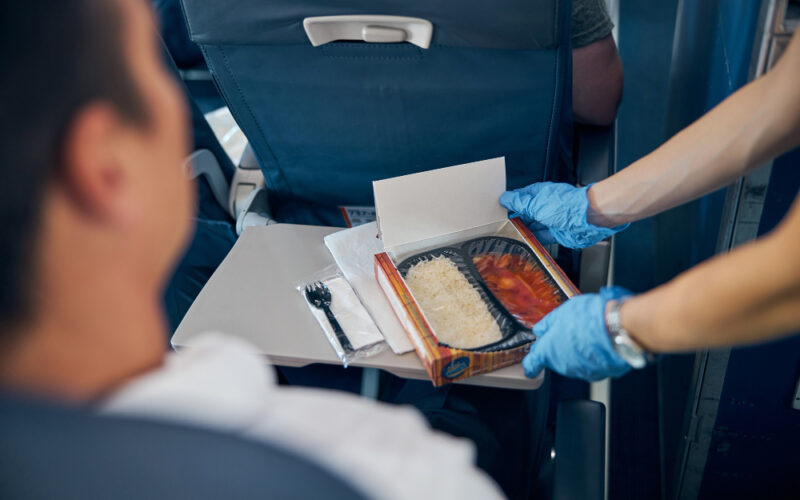Introduction
Have you ever had in-flight meals? In-flight meals are meals served on a plane while flying long distances. This is also known as airline food. Depending on the airline and flight, different foods, snacks, and drinks are available. This is an important factor in people’s plane selection today.
History of In-flight meals
How did the in-flight meal come about? In the 1920s, the first in-flight meal was served. Because they didn’t have enough technology to cook food on the plane at the time, they sold cold salads, sandwiches, and fruits. In the 1930s and 1940s, technological advances in airplanes enabled passengers to select more diverse in-flight meals. The plane’s kitchen was now operational, allowing the airline to serve hot food. Finally, high-end food appeared in 1960s in-flight meals. However, in-flight meals have not always been well received. Because of the risk of terrorism and safety concerns, passengers and airlines used to prefer a simple in-flight meal. However, people have come to regard in-flight meals as an important airline service, and airlines have responded by offering a variety of snacks and unique menus. In-flight meals have become more advanced and can serve more demanding dishes. Recently, passengers could even choose to grill steak.
Special In-flight meal menu
Passengers can now select from a wider range of in-flight meals. Airlines typically provide special foods such as allergy-free food, baby food, diet low-calorie food, bland food, vegetarian food, religious food that does not include pork or beef, and fruit food (www.aa.com, n.d.). If a passenger wants a special menu, they must make a reservation at least one day before the flight because some foods must be prepared separately. However, the airline also provides two or three regular food options to passengers. On a flight from the East to the West, for example, passengers can select one type of Asian food or one type of Western food for in-flight meals. Some airlines create their own unique in-flight meals. It also serves traditional foods from the airline’s home country or foods that are not commonly served as in-flight meals. Airlines provide more service to passengers who purchase higher-priced seats, such as business or first-class seats. More snacks and drinks are available, as well as course meals during mealtime. Some airlines have on-board chefs who prepare their own meals and serve them to first-class passengers.
How to clean up in-flight meal trash?
We usually eat our in-flight meals in disposable containers. Bowls are also important for high-priced seats, so food is rarely served in disposable containers, whereas regular seats, which account for a large percentage of passengers, typically use plastic containers and paper cups to serve meals. So, how do people get rid of this garbage? As previously stated, due to the nature of the in-flight meal, which provides a variety of options, it carries food that can be eaten by more people than the number of passengers. Also, because some passengers do not eat in-flight meals due to illness or lack of sleep, the amount of food left is enormous. Companies that provide in-flight meals collect and discard these foods. This is due to the risk of food poisoning if you consume contaminated in-flight meals. A new technology has recently been introduced to reduce food demand by predicting food demand using artificial intelligence (AI), and an environmental plan to donate unused food to the local community is being promoted.
Conclusion
In-flight meals have been steadily evolving for the convenience of passengers and the high quality of service on airplanes since their introduction around 100 years ago. Airlines, in particular, are developing technologies to reduce waste disposal and benefit the environment.
Reference
Ben, A. (2019). A Brief History of In-Flight Meals. [online] Fortune. Available at: https://fortune.com/longform/airlines-in-flight-meals/ [Accessed 8 February 2023].
Chan, D. (2021). That airline meal you declined likely ends up in the trash. [online] South China Morning Post. Available at: https://www.scmp.com/lifestyle/travel-leisure/article/3116767/airline-food-waste-no-meal-option-ai-identify-uneaten [Accessed 8 February 2023].
Michele, H. (2022). The History of Inflight Dining. [online] Reader’s Digest. Available at: https://www.rd.com/list/history-of-inflight-dining/ [Accessed 10 February 2023].
www.aa.com. (n.d.). Special meals and nut allergies − Travel information − American Airlines. [online] Available at: https://www.aa.com/i18n/travel-info/experience/dining/special-meals-and-nut-allergies.jsp [Accessed 10 February. 2023].
Clampet, J. (2013). 17 Milestones in the History of Airlines’ In-Flight Meals. [online] Skift. Available at: https://skift.com/2013/10/11/17-milestones-in-the-history-of-airlines-in-flight-meals/ [Accessed 9 February 2023].
Kerry, H. (2015). Airplane Food: What a Waste! [online] Airport Lifestyle. Available at: https://airportlifestyle.com/airplane-food/ [Accessed 9 February 2023].
